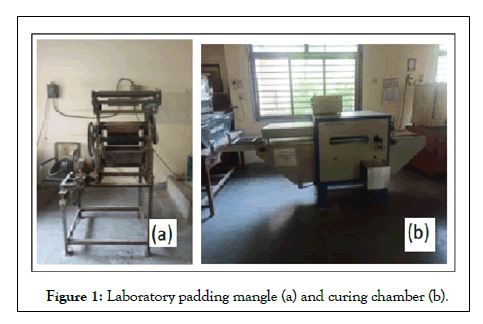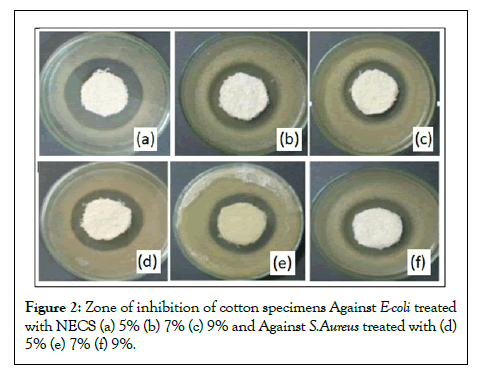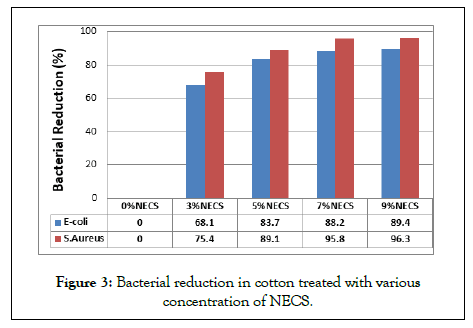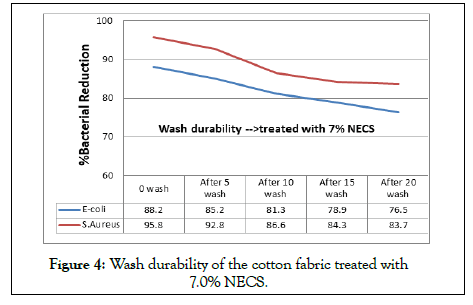Journal of Applied Pharmacy
Open Access
ISSN: 1920-4159
ISSN: 1920-4159
Research Article - (2022)Volume 14, Issue 1
In the present pandemic scenario, the new quality textile requirements not only emphasize on the intrinsic functionality and long service life of the product but also functional finish processes that should be environmentfriendly. To impart and enhance the antibacterial functionality to cotton textiles, research on environment-friendly antibacterial agents based on natural products is gaining worldwide interest. The present research aims to impart a natural antibacterial activity on cotton textiles with the help of plant extracts. Plant leaf extracts are applied though Pad-Dry-Cure technique. The effect of these herbs on antibacterial activity of cotton fabric evaluated through standard test methods. Encouraging results indicate that cotton having no antibacterial activity gained the same and enhanced with increasing treatment conditions. Also imparted antibacterial activity found to be durable and retained in the substrate even after 20 laundering cycles.
Staphylococcus aureus; Escherichia coli; Antimicrobial; Eucalyptus
With an increase in corona outbreak the entire globe's focuses on health and hygiene. Thus, healthcare industry increasing awareness about personal hygiene and Textile Industry is all ready to set a new bar embracing hygiene with antimicrobial fabrics [1]. In this paper an effort is made for a detailed research on natural plant based bioactive agents such as Azardirachta Indica and Eucalyptus globulus to impart/enhance antibacterial functionality to cotton textile substrates. Azardirachta indica commonly known as neem. More than 300 active compounds can be isolated from different parts such as leaves, bark and seeds of Neem tree but, the most important limonoids are azadirachtin, salannin and nimbin. Eucalyptus globules are also rich source of phytochemical compounds as flavonoids, alkaloids, tannins and propanoids, extracted from the leaves of the plant. Several volatile constituents such as 1, 8-cineole (eucalyptol) aromadendrene, α-gurjunene, globulol, ß-pinene, pipertone, α-,ß-and γ-terpinen-4-ol, and alloaromadendrene were also found both in leaves and in shoots [2]. Generally some plants have their own ability to protect them from pest attack, because of presence of numerous biologically active compounds having antimicrobial properties.
Antimicrobial fabrics work the same way antimicrobial soaps and sanitizers i.e.by attacking pathogens on a cellular level to prevent their growth and reproduction. Different chemicals and textiles have different levels of effectiveness. Some merely slow the spread of pathogens over time, while others are designed to kill spore cells on contact. Antimicrobial finish offers protection against bacteria, fungi, mildew, and other hazardous microbes. This can be achieved by treating the fabric with a proprietary topical chemical that inhibits the growth of pathogens. Various synthetic chemicals are available for this purpose but they are very harmful to the environment [3].
Plant based natural active agents are complex mixtures of volatile organic compounds which may possess antimicrobial activities. These active agents were extracted from the medicinal plant herbs, which are already used as antiseptics to cure various diseases since long time. They are natural, safe and have no any adverse consequences on environment and are being used widely to overcome the problems caused by harmful synthetic agents on environment.
Research questions of the study
1. How to impart antibacterial functionality to cotton textile substrates?
2. Can natural antibacterial agents replace synthetic ones?
3. What about the durability of antibacterial functionality imparted to cotton textile
Research design
In this research cotton fabric is subjected to natural bioactive agent to study the antibacterial activity against bacteria E-coli and S. aureus. The treatment conditions varied to enhance functionality.
Materials
The fabric composed of 100% cotton fibre used for the present study. Azardirachta Indica and Eucalyptus globules were selected as natural bioactive herbs and extracted from the leaves using methanol extraction standard method [4].
Treatment methods
A complex mixture having equal proportions of both the plant leaves extract (NECS) was prepared and used for the study. After pretreatment, Cotton fabric samples were soaked at 90ᵒC for 30 minutes in padding liquor of four different concentrations i.e. at 3.0%, 5.0%, 7.0% and 9.0% of Neem-Eucalyptus Complex mixture (NECS) containing citric acid (1%) as binder. Samples then padded on laboratory two bowl padding mangle (Figure 1a) with 3dip-3nip (70% wet pick up) technique. Padded samples were air dried for 30 minutes at room temperature and cured on a laboratory Curing Chamber at 120ᵒC for 5 minutes (Figure 1).

Figure 1: Laboratory padding mangle (a) and curing chamber (b).
Evaluation of treated samples
Parallel Streak Method AATCC 147-2004 and Bacterial reduction Method AATCC 100-2004 were employed to evaluate the antibacterial activity of the finished samples qualitatively and quantitatively respectively using a laboratory launder-O-meter under standard conditions [5]. Escherichia coli (Gram negative bacteria) and Staphylococcus aureus (Gram positive bacteria) were used in this study. For parallel streak method, specimen of test material and untreated control fabrics were placed on AATTC medium which has been previously streaked with inoculum of test organisms. After incubation, a clean area of interrupted growth underneath and along the sides of test material indicates antibacterial activity of the specimen [6].
Data analysis
Outcome of assessment results were analyzed through tabulation, bar chart and line diagrams. Comparative study was carried out of various treated specimens.
Antibacterial activity
The results of parallel streak method AATCC 147-2004 are illustrated in Figure 2 in form of images of zone of inhibition. The size of the zone of inhibition (The area where bacteria are unable to grow) caused by the presence of the antibacterial agent was used to estimate the antibacterial activity.

Figure 2: Zone of inhibition of cotton specimens Against E-coli treated with NECS (a) 5% (b) 7% (c) 9% and Against S.Aureus treated with (d) 5% (e) 7% (f) 9%.
Untreated cotton found to have no antibacterial activity with zero area. Zone of inhibition detected in treated fabric specimen against both bacteria (Figure 2) and increases with increase in concentration of complex mixture of natural bioactive agents (NECS) (Table 1). This clearly indicates that cotton acquires antibacterial activity as a result of treatment with complex mixture of natural bioactive agents (NECS) and protection against both bacteria enhanced drastically with increase in concentration. Against bacteria E-coli, zone of inhibition increases from 4.3 to 14.1 mm with increase in concentration from 3.0 to 9.0%. Similarly an increase from 10.3 to 20.1 mm was observed against bacteria S. Aureus under the same conditions.
| Concentration of NECS (%) | Zone of inhibition (mm) against bacteria | |
|---|---|---|
| E. coli | S. aureus | |
| Untreated (0%) | 0 | 0 |
| 3 | 4.3 | 10.3 |
| 5 | 8.5 | 16.7 |
| 7 | 13.8 | 19.7 |
| 9 | 14.1 | 20.1 |
Table 1: Antibacterial activity of cotton treated with natural bioactive agent.
Percent bacterial reduction
Bacterial reduction Method AATCC 100-2004 was used for quantitative evaluation of degree of antibacterial activity of treated specimens. The results are illustrated in Figure 3.

Figure 3: Bacterial reduction in cotton treated with various concentration of NECS.
Untreated sample shows zero% bacterial reduction indicates no antibacterial activity. Cotton acquires Antibacterial activity when treated with 3% NECS with bacterial reduction 68.1% and 75.4% against E.coli and S.Aureus respectively. Higher the percent bacterial reduction better will be the degree of antibacterial activity. The results reveal that against both bacteria under study increase in percent bacterial reduction observed with increase in concentration of NECS. The highest degree of antibacterial activity (indicating 96.3% bacterial reduction) is achieved with concentration 9.0% against bacteria S. Aureus.
Durability of Antibacterial activity
The quantitative test method AATCC 100 was also used to study the durability of antibacterial activity of cotton. The samples treated with 7.0% NECS quantitavily assessed after 0, 5, 10 and 20 laundering cycles in terms of percent bacterial reduction. The results are analyzed through line diagram given in Figure 4.

Figure 4: Wash durability of the cotton fabric treated with 7.0% NECS.
It is observed that as laundering cycles increases from 0 to 20 percent bacterial reduction drops steadily against both bacteria. But the magnitude of drop is very nominal (e.g. from 88.2% to 76.5% bacterial reduction of E.coli bacteria) after 20 launderings indicates maximum retention of antibacterial activity even after 20 launderings. Similar trend observed in case of S.aureus also i.e. from 95.8% to 83.7% bacterial reduction. Thus a durable antibacterial activity is imparted to cotton textile substrates using complex mixture of natural herbs (NECS).
Untreated cotton fabrics do not possess antibacterial activity against bacteria E-coli and S.Aureus as observed Treatment with mixture of Eucalyptus and neem extract imparts antibacterial activity in cotton. This is due to presence of various classes of active ingredients in extracts of natural bioactive products used in this study. These ingredients act differently with the substrates to enhance their antibacterial activity. Eucalyptus has many substances like flavonoids, alkaloids, tannins and propanoids having antimicrobial and antifungal activities [7]. These substances have the ability to bind adhesions, complex with cell wall, inactivate enzymes, denaturing proteins and disrupt the membrane to limit the growth of microbes by disabling cell functioning or reproduction [8]. The neem extract contains substances like Azadirachtin nimbinin active limonoids also, flavonoids, dihydrochalcone, coumarin and tannin. These substances not only interfere with the cell wall division during reproduction but also with protein synthesis as well [9]. Both being antimicrobial by themselves, when used in complex with each other synergetic effect is obtained and results in drastic improvement with increase in treatment concentration from 3.8% to 5.0%.
When used in combination of equal proportion of Eucalyptus and neem extract, due to synergetic effect they remain embedded in the substrate strongly. There by difficult to remove by washing treatment. This characteristic imparts durability to laundering. In this study durability assessed up to 20 laundering cycles and found to be excellent.
This is a comprehensive study on antibacterial activity of cotton textiles. Antibacterial activity can be imparted to cotton by treatment with natural bioactive herbs to different extent using various concentrations. Different natural herbs in combination produce synergetic effect with increase in concentration the degree of antibacterial activity increases. The optimum activity imparted with concentration 7%. A durable antibacterial finish up to 20 laundering cycles is successfully imparted to cotton. This study reveals that the herbal leave extracts of our two natural bioactive agents can be used to develop herbal anti-bacterial finished ecofabrics for a healthier life.
[Cross Ref ] [Google Scholar]
[Cross Ref ] [Google Scholar]
[Cross Ref ]
[Cross Ref ] [Google Scholar]
[Cross Ref ] [Google Scholar]
Citation: Pachauri RD, Shah JN (2022) Studies of Antibacterial Properties on Cotton Textiles Treated with Natural Bioactive Compounds. J Appl Pharm. 14:330.
Received: 06-Jan-2022, Manuscript No. JAP-22-15672; Editor assigned: 08-Jan-2022, Pre QC No. JAP-22-15672(PQ); Reviewed: 23-Jan-2022, QC No. JAP-22-15672; Revised: 25-Jan-2022, Manuscript No. JAP-22-15672(R); Published: 02-Feb-2022 , DOI: 10.35248/1920-4159.22.14.330
Copyright: © 2022 Pachauri RD, et al. This is an open-access article distributed under the terms of the Creative Commons Attribution License, which permits unrestricted use, distribution, and reproduction in any medium, provided the original author and source are credited.